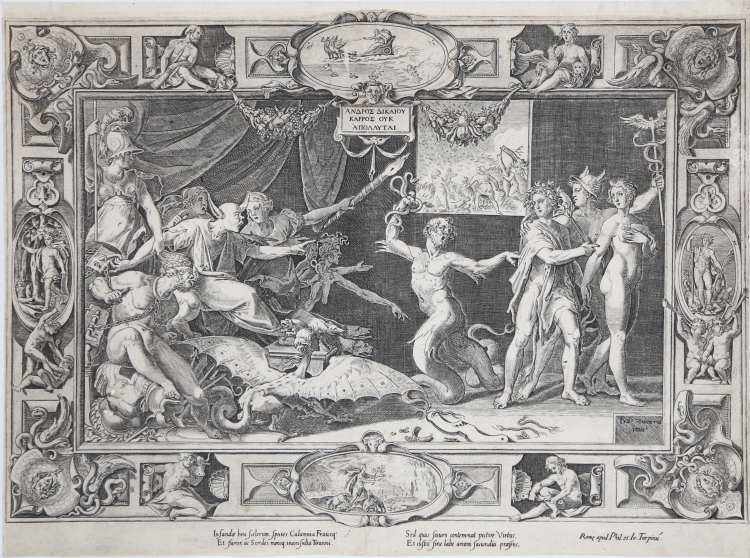



| Reference: | S46040 |
| Author | Anonimo |
| Year: | 1580 ca. |
| Measures: | 415 x 310 mm |


| Reference: | S46040 |
| Author | Anonimo |
| Year: | 1580 ca. |
| Measures: | 415 x 310 mm |
Copy in the same direction of Cornelis Cort's engraving after Federico Zuccaro's 'The Calumny of Apelles' (Hampton Court Palace).
Engraving, circa 1580, lettered in cartouche at top centre with Greek characters: "Andros dikaiou / karros ouk / Apollutai", in panel at bottom right of central composition: "Fred. Zuccarus inven", below image with four lines of Latin verse beginning: "Infanda heu scelerum species Calumnia Frausq. ...'.
Example of the second state with the imprint of P. Thomassin and J. Turpin.
A good impression, printed on contemporary laid paper, trimmed to the platemark, minimal restorations in central part visible on verso, otherwise in excellent condition.
“In 1566, Cornelis Cort settled in Rome, where he engraved prints for several artists, including twenty-four after com- positions by the notoriously difficult Federico Zuccaro. The Calumny, one of Zuccaro's three pictorial tirades, was his response after being dismissed in 1569 as principal painter at Cardinal Alessandro Farnese's palazzo at Caprarola. There are two painted versions, one in the royal collection at Hampton Court Palace, and another, slightly different version in the Palazzo Caetani, Rome, to which Cort pre- sumably had access. John Shearman describes this complex allegory as "one of the most interesting and important sec- ular works of the second half of the Cinquecento."
The Calumny is based on the ekphrasis "On Slander" by the Roman writer Lucian of Samosata, ostensibly describing a painting by Apelles of Cos, a renowned Greek painter active in the late fourth century BCE. It is uncertain, however, whether the painting actually existed, or whether Lucian invented it for his ekphrasis, as a rhetorical exercise. According to Lucian, Apelles was accused of fomenting a rebellion in Tyre and sentenced to death. A friend then proved that it was impossible for Apelles to have been involved, and the slanderer was sold into slavery. The painter remained indignant, however, and avenged himself by painting an allegorical picture showing Calumny inveigling the king, whom he portrayed with the ears of an ass. Perhaps because Leon Battista Alberti referenced Lucian's text in his treatise On Painting (1435), several artists attempted to "re-create" Apelles's painting precisely, whereas Zuccaro freely adapted the tale to avenge being fired. For example, in Lucian's account Calumny, accompanied by Envy, Treachery, and Deceit, drag off the slandered artist, but in Zuccaro's version, the painter is rescued by Mercury and Innocence, who holds an ermine, a symbol of purity.
The characters can be identified with certainty because in 1628 Federico's son Octavian published a detailed description of the composition. On the left, the ass-eared king is turned against the painter by Suspicion and torch-bearing Calumny. In front of them is the emaciated figure of Envy, with snakes in her hair. Beside her are animals representing vices: a fox (Cruelty), wolf (Malice), toad (Avarice), and a leopard (Fraudulence). The snake-legged harpy represents Greed or Covetousness, and the hybrid creature in the foreground represents Perfidy. On the far left, stalwart Minerva restrains the king from releasing the shackled figure of Rage.
The engraved frame is similarly instilled with meaning. Each corner features a symbol of Minerva, the goddess of wisdom, who will ultimately convince the king of the painter's innocence. In the central cartouche on the left, Aeneas holds the Golden Bough that helped him on his journey to Hades; above is Federico's own emblem, a sugar-loaf (zucchero). On the bottom, Aeneas is flanked by a youth embracing an ox, symbolizing noble Toil, and a man breaking a yoke, signifying Servitude. On the right, Hercules holds the palm of Victory as he impales two monsters, while putti trumpet the Fame and Glory that accompany Virtue. The window in the upper center opens onto a scene with peasants watching the destruction of their crops, signifying disappointment instead of the rewards they expected. At the top, Juno rides her chariot drawn by peacocks over a placid sea upon which kingfishers (halcyons) nest, signifying Halcyon Days or the calm achieved by Virtue. She is flanked on the left by Hercules, who rests from his labors, and a young man embracing an eagle and lion, representing virtuous thoughts” (cf. B. Barryte, Renaissance Impressions. Sixteenth-Century Mastre Prints from the Kirk Edward Long Collection, p. 182).
Bibliografia
The New Hollstein: Dutch and Flemish etchings, engravings and woodcuts 1450-1700 (211); Bierens de Haan 1948, L'oeuvre gravé de Cornelis Cort, graveur hollandais 1533-1578 (219, copy A); B. Barryte, Renaissance Impressions. Sixteenth-Century Mastre Prints from the Kirk Edward Long Collection, p. 182, n. 60.
Anonimo
Anonimo